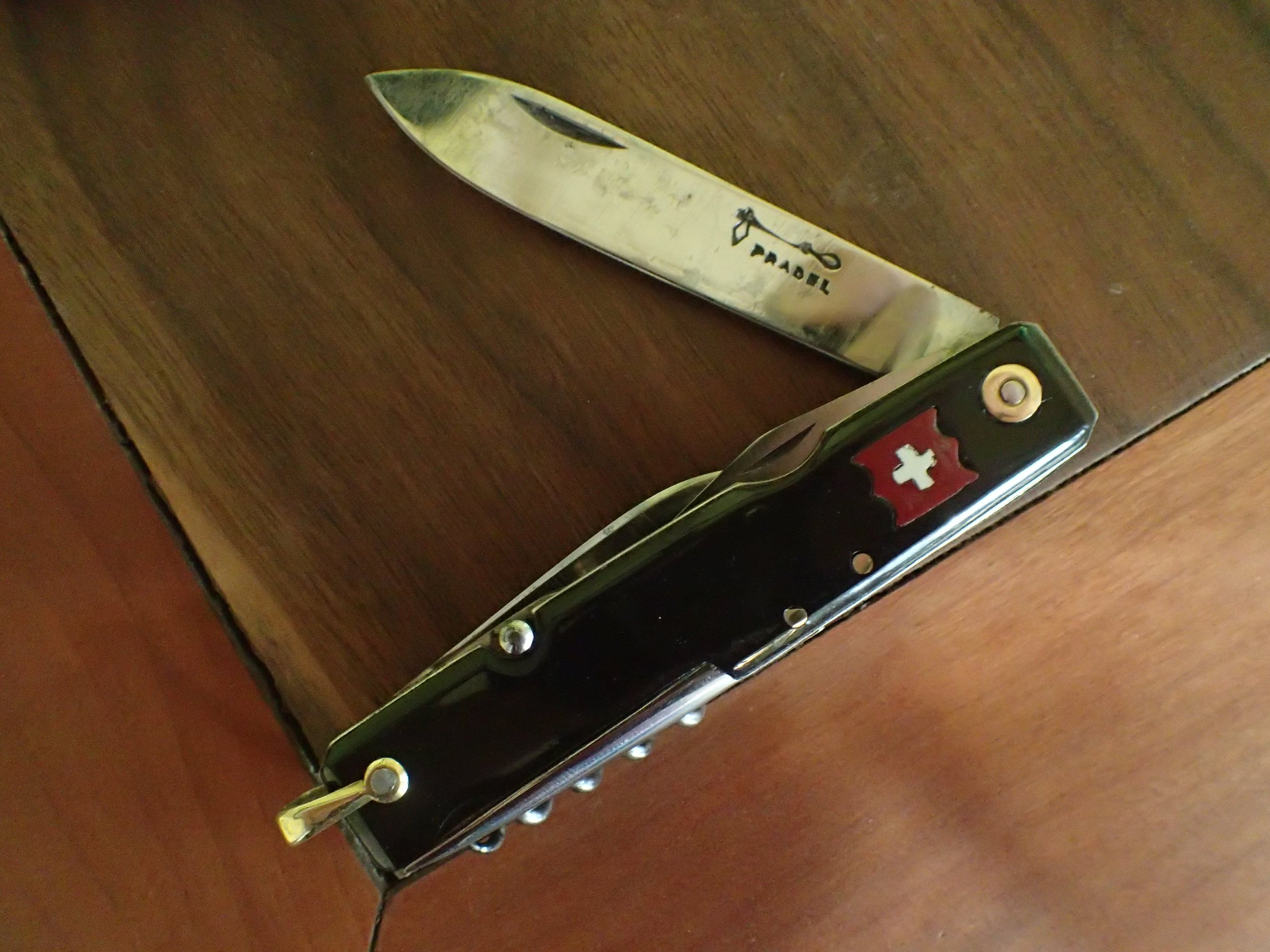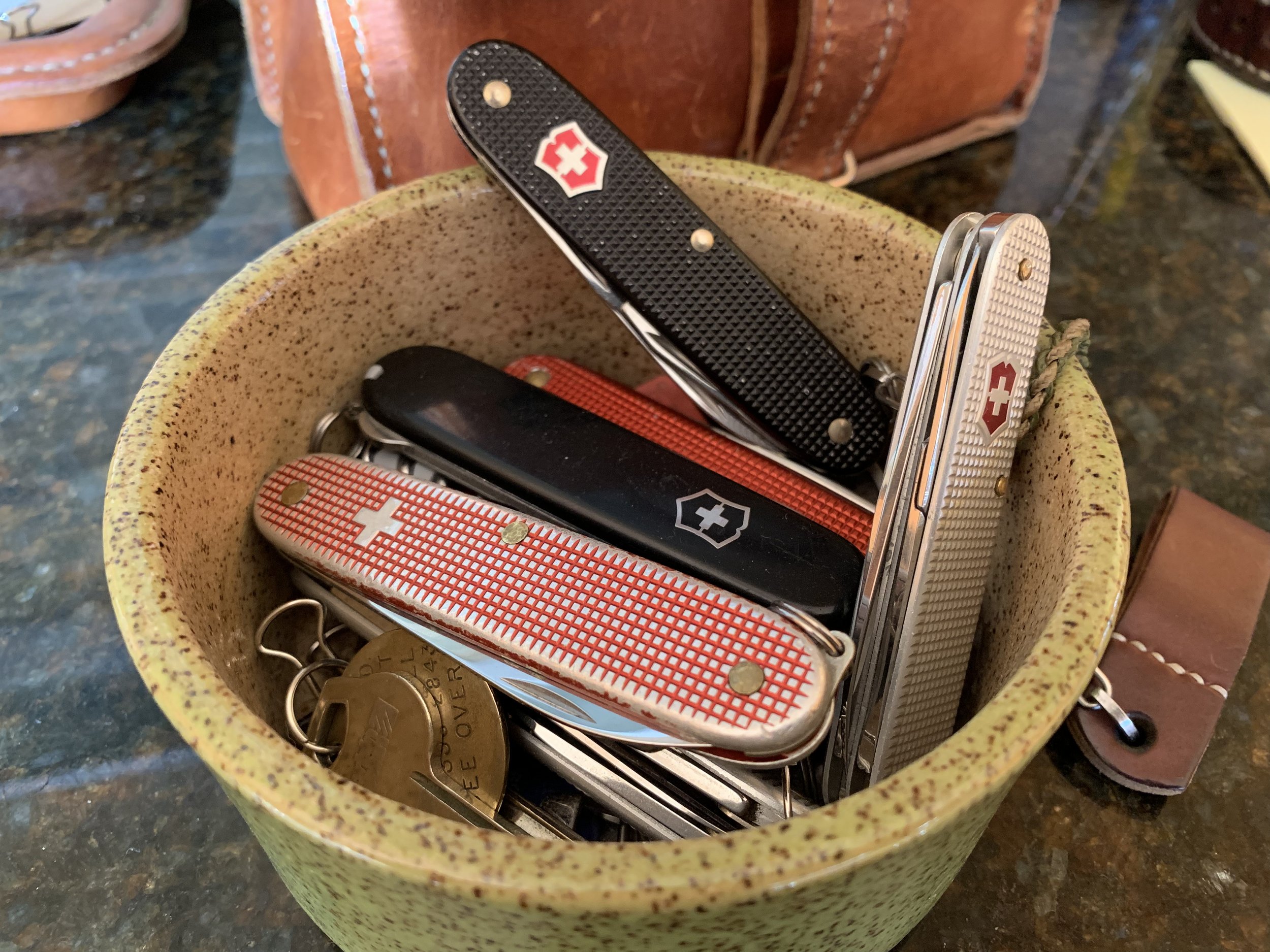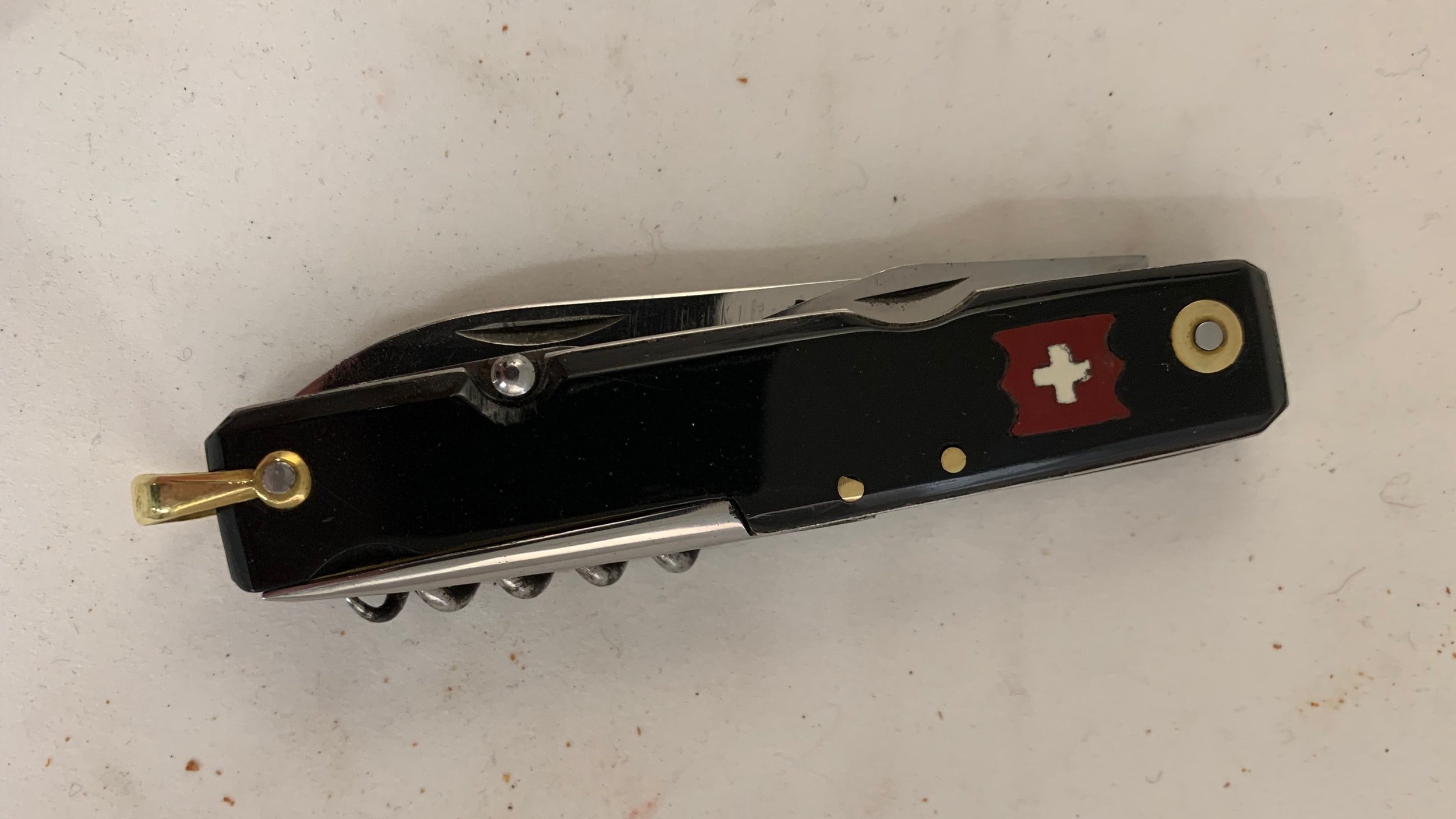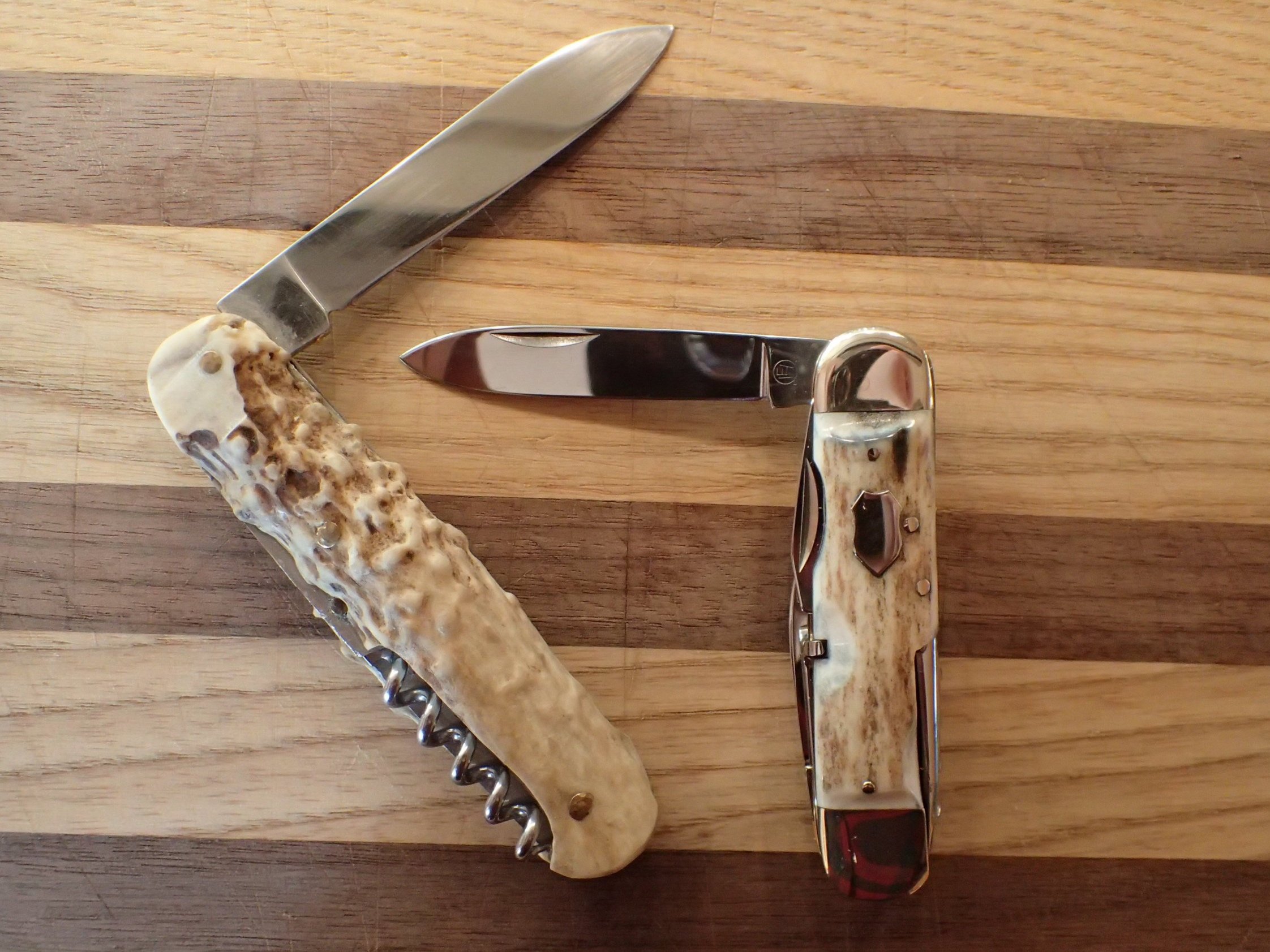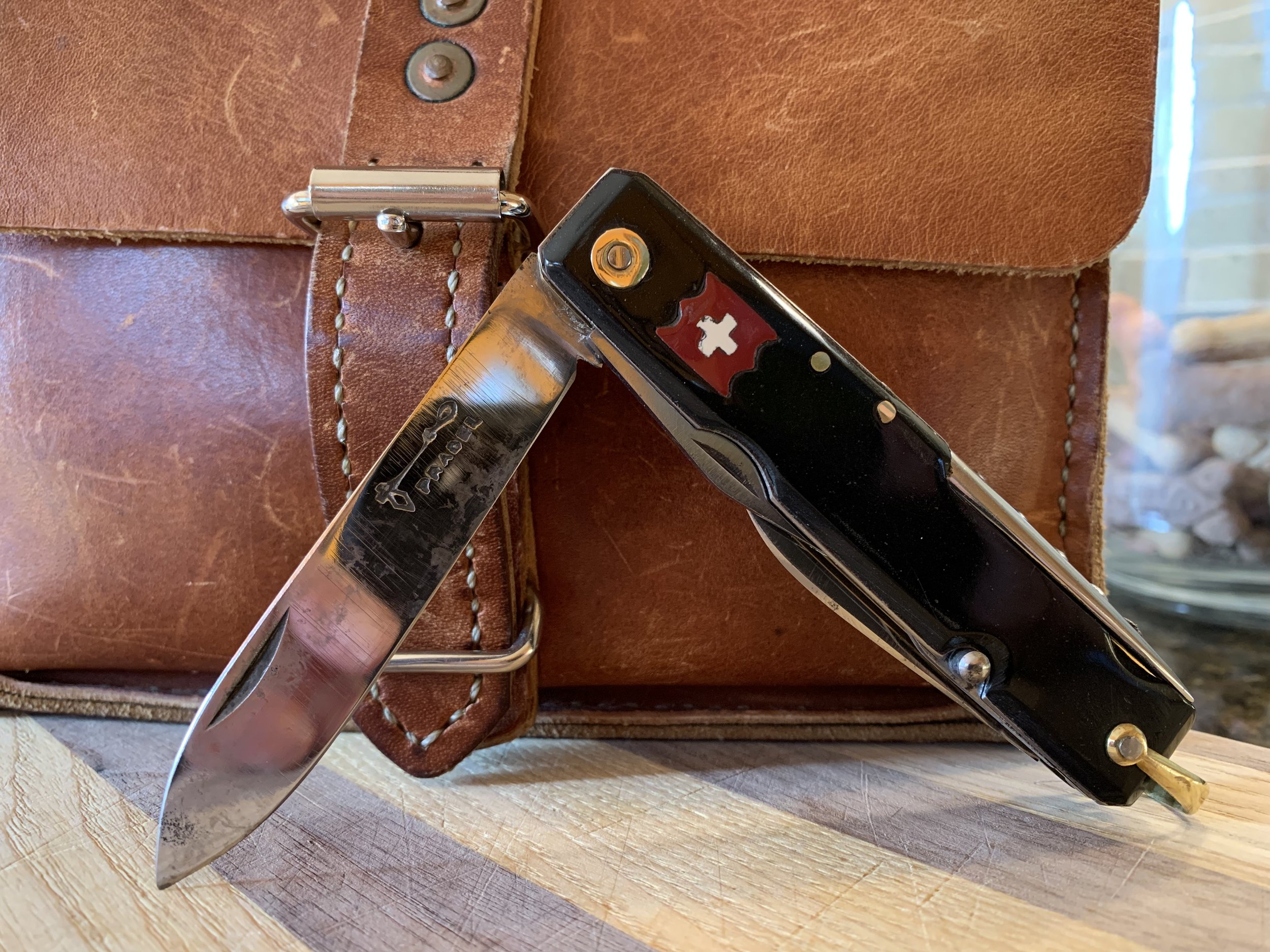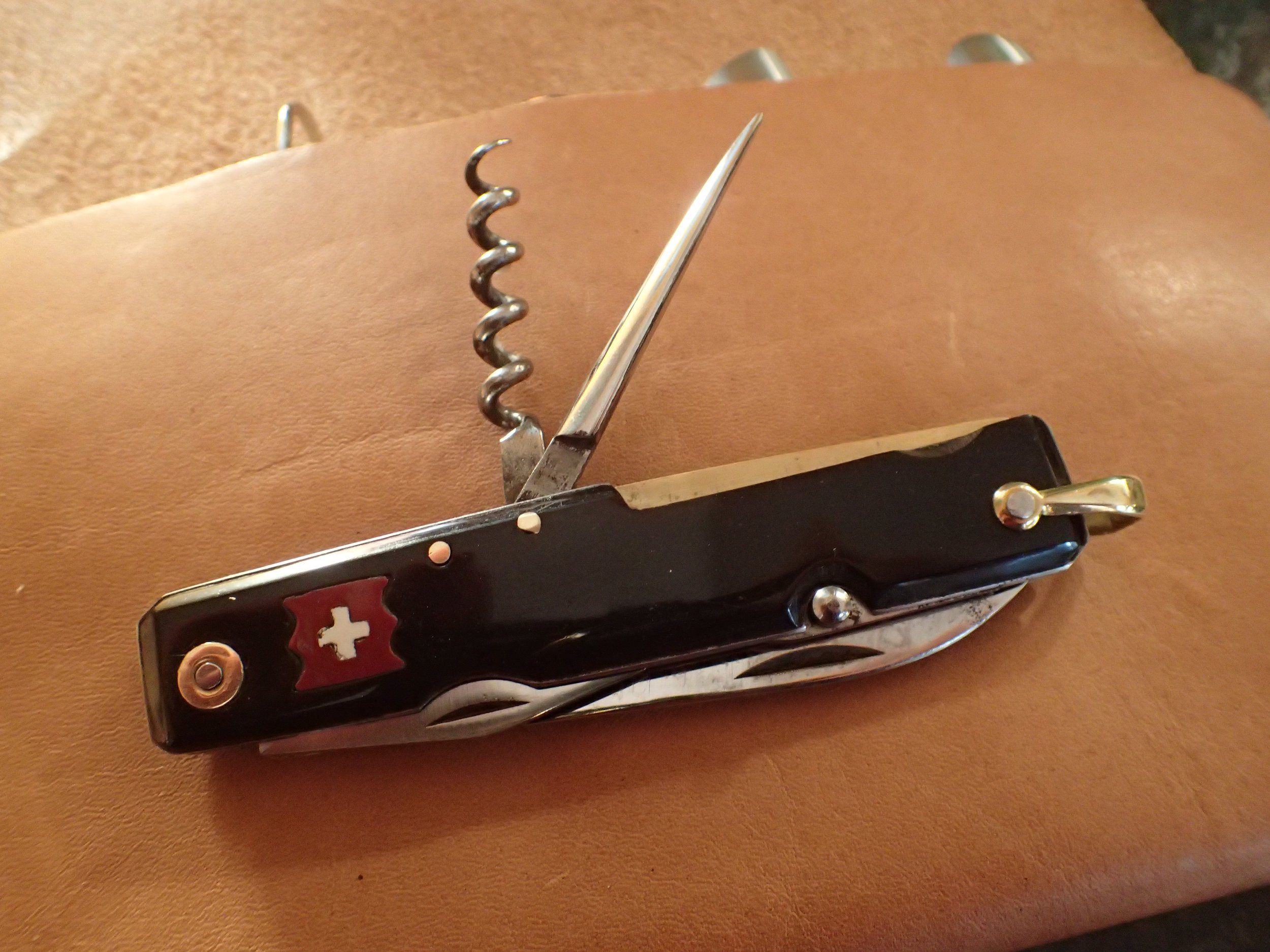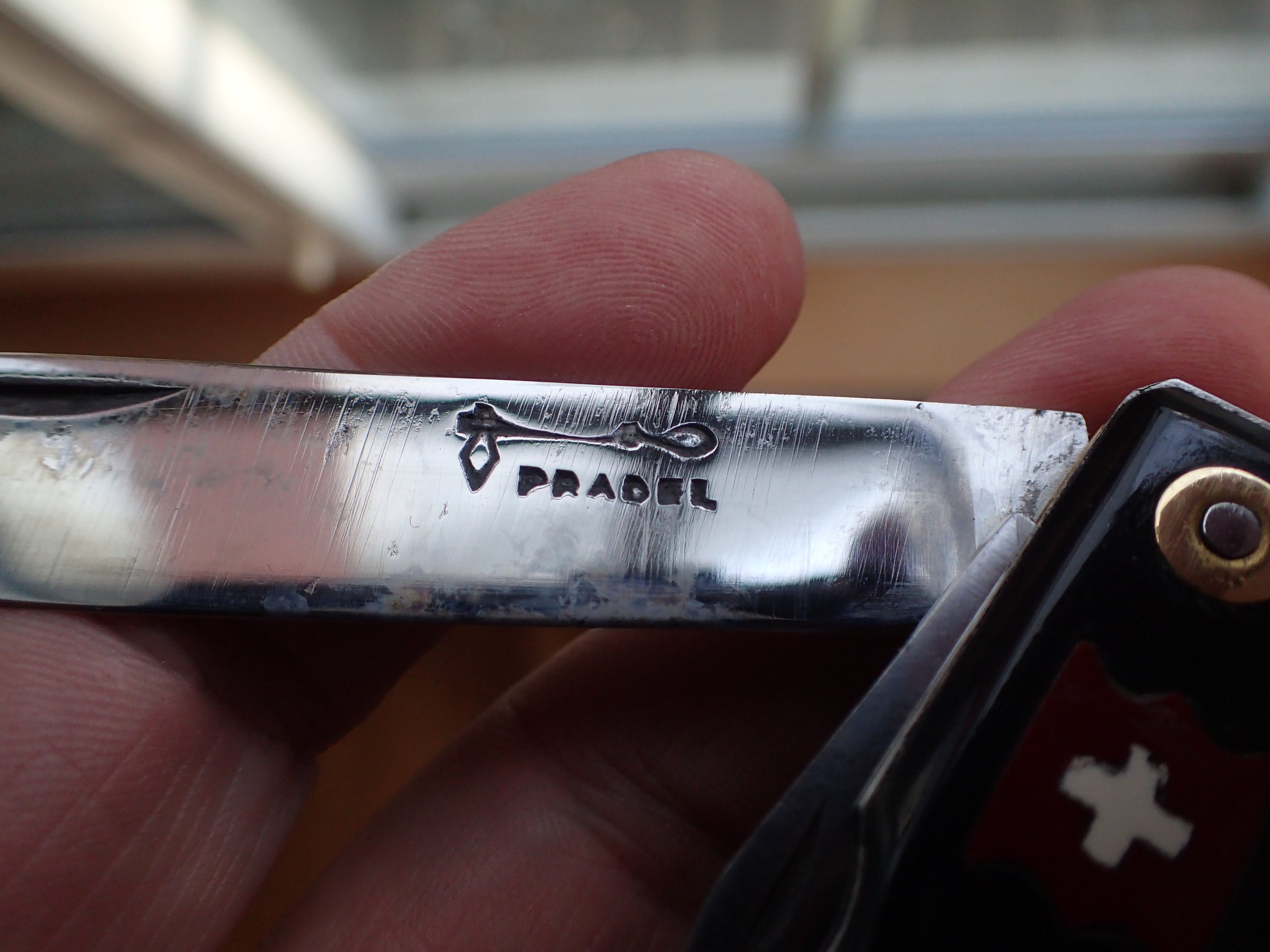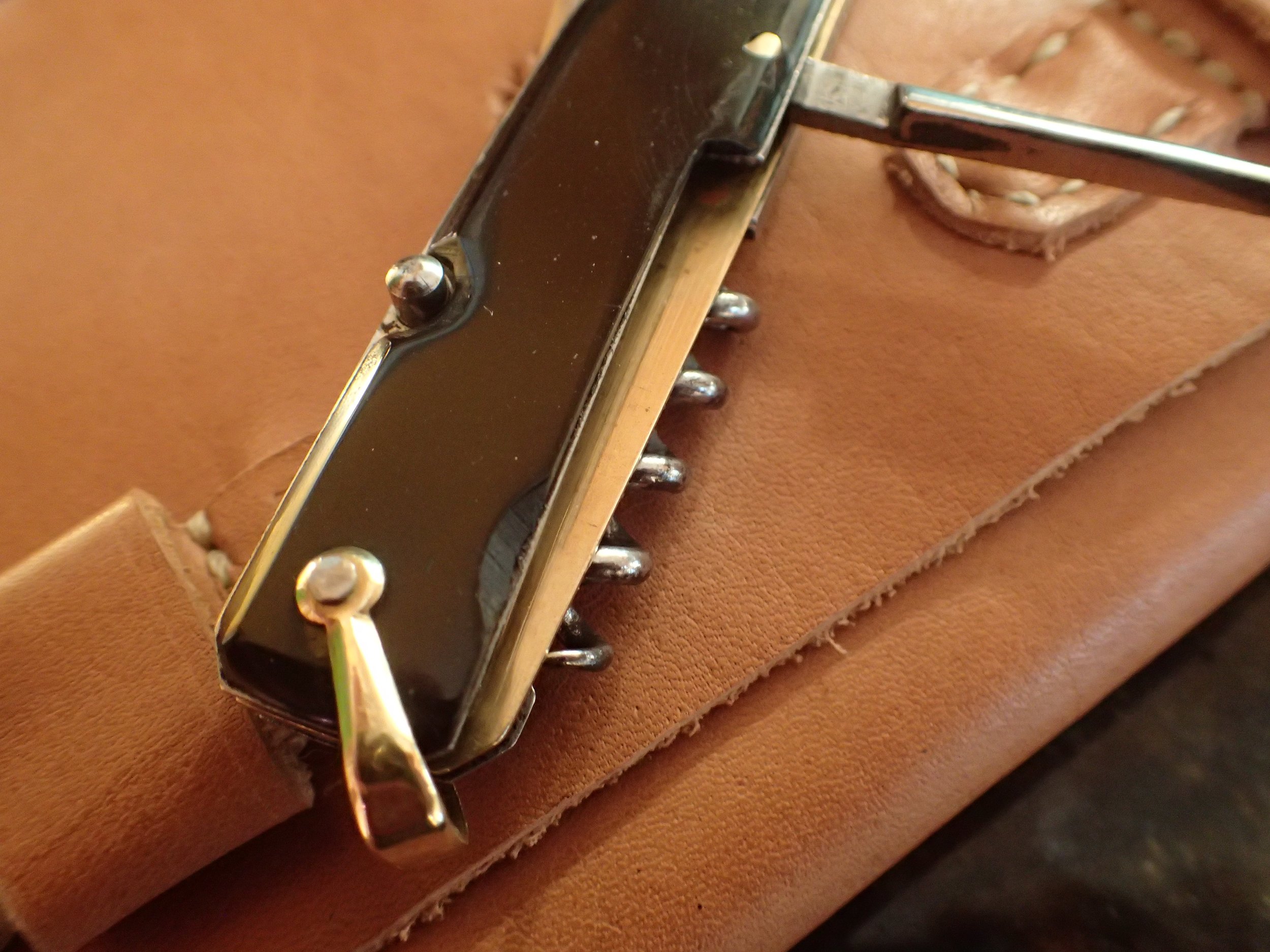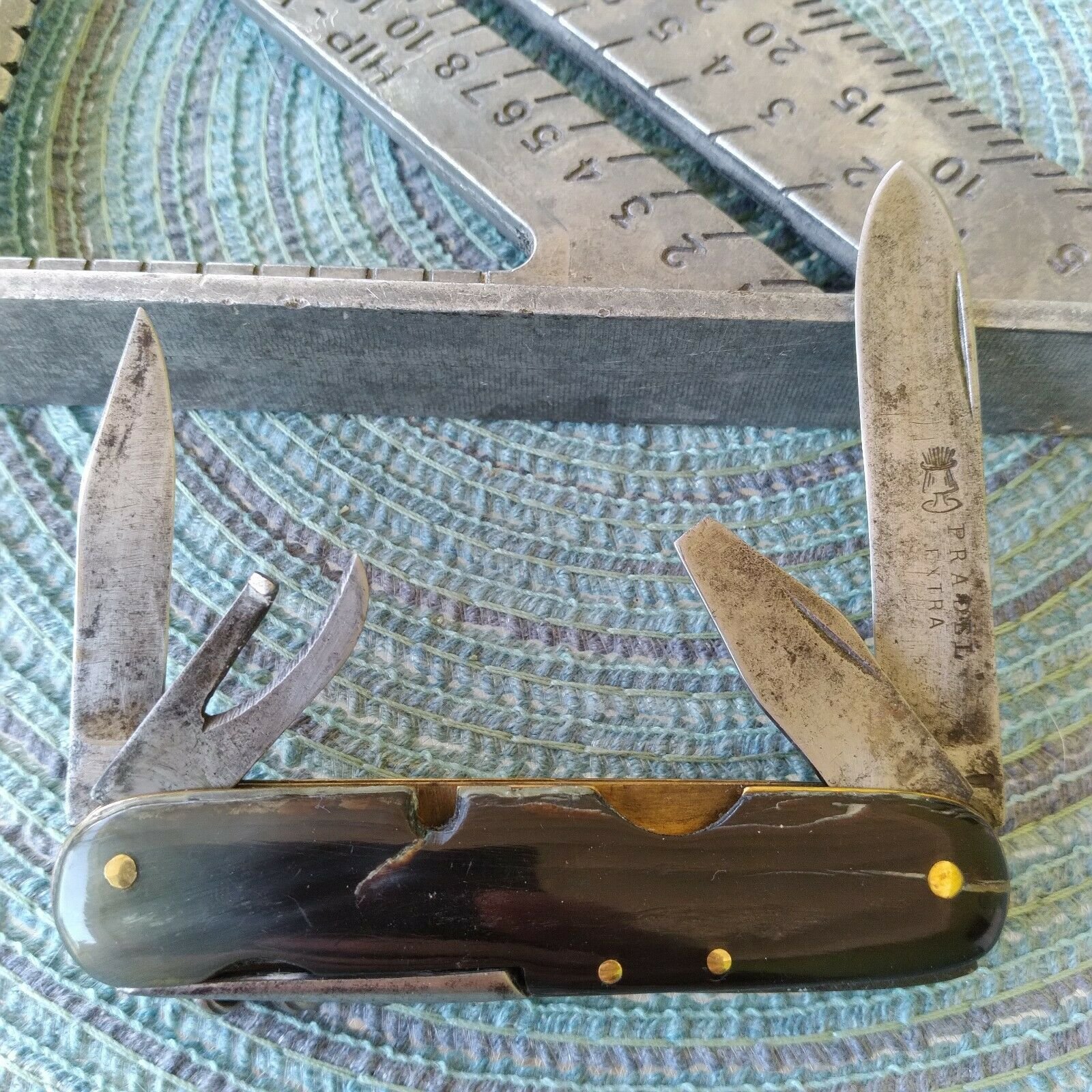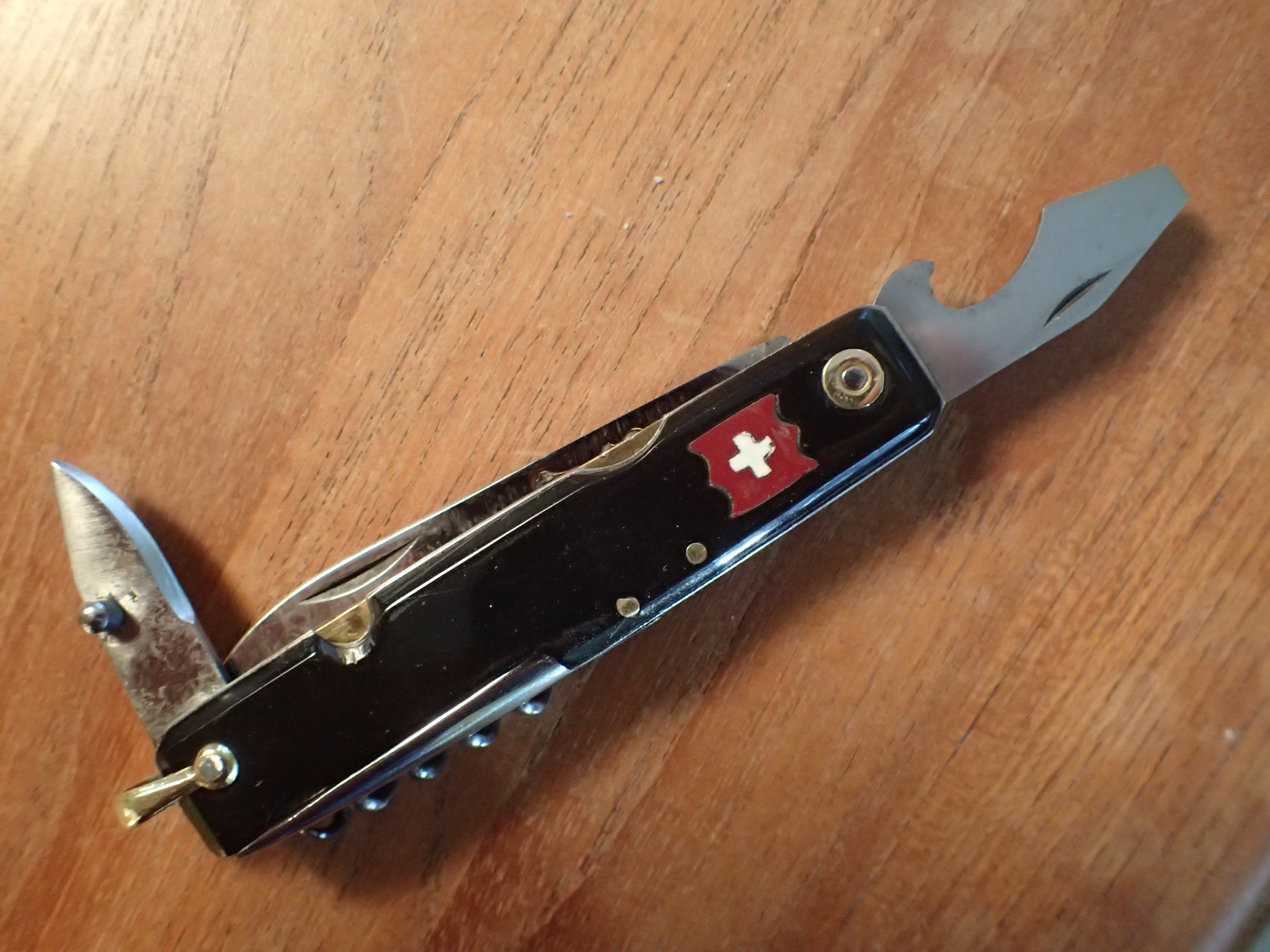The Pradel Scout-Pattern Knife: Mysterious Vintage French Pocket Tool.
Myron Erickson
Collector? Or just an accumulator?
Regular readers might recall my differentiating between collection and accumulation. A collector is looking for certain characteristics, such as age, manufacturer, design, or specification. Even if you don’t love it or plan on using it, if it’s part of the set you must find it. The Confusing Fall Warblers, for example. Or, ahem, every variation and issue-year of the Model 1961 Soldier SAK to name another. The act of collecting, our fascination with it, why some people feel the compulsion to collect while others are immune, fascinates me.
I can’t pretend that this is anything other than a collection. Just a part of one, actually.
Accumulators, on the other hand, follow their whims, buying a new thing when the old thing wears out or fails to thrill. It might be sweaters, coffee cups, watches, or pocket knives, but it’s not like the old one just gets thrown away. No, it gets chucked into a drawer or cupboard if it doesn’t get handed down or given away. And the New Shiny Thing, no matter how small or non-public-facing, is a lift to your day and reduces your dread of the next Monday morning. Accumulation may start out innocently enough, but there’s no denying that it is also the first step down the Slippery Collector Slope.
An accumulation of SAKs I use every day.
When it comes to pocket knives, I am both. Collector me has a few homemade nesting trays for storing purposefully sought and carefully cataloged SAKs and other pocket knives that fit the collector definition. I possess them to possess them, the malady and madness of the true collector. But the half-dozen knives I pick from to carry and use every day? They’re just an accumulation of favorite pocket tools past and present, among which you’d find a Victorinox cheese knife, a couple Pioneers, a couple Cadet/Voyageur mods, and a Compact.
Nice Hartkopf. Wait, what’s a Pradel?
The aimless Accumulator mindset recently found me perusing the sales corner of multitool.org where I saw that a longtime watch and SAK pen pal in London had listed a few knives for sale. Knife-wise, my friend David is into whittlers and SAKs, but we also have canoeing and caravanning in common. He’s apparently much better than I am at clearing out the clutter when needs must, however. Hence he had listed three knives for sale, two of which were of interest to me, one because it was on my list already — a stag-scaled, traditional scout-pattern knife from that historic Solingen maker, Hartkopf. The other was a beautifully ugly, gracefully ungainly, strangely compelling French-made scout-pattern knife that I’d never encountered, but which nevertheless caught my fancy, a “Pradel.” I put the word in quotation marks for reasons I will explain later.
The Pradel scout-pattern knife from ca. 1960-70’s. Note the handsome brass bail, pins, and rosette.
I dropped my friend David a line and although he refused to take any money for his knives, he was happy to trade for some 84 mm SAKs I had that would work for a modding project he was considering. So we traded transatlantic parcels and thus each got that small but familiar thrill of opening a package of New Shiny Things that has come all the way from somewhere else. Who doesn’t love that?
The Hartkopf, my first from this maker, was exactly what I expected it to be — beautifully and traditionally built, with all the hallmarks of Solingen quality. It is an amazing addition to my collection of scout pattern knives, all the more special because it was given to me by a friend. As it happens, I made my own stag-scaled knife once and know a little about it. I started with a Victorinox 108 mm German Army Knife, deleted the saw/opener implement, and then re-assembled it as a single layer picnic knife with my own stag scales that I made from the antlers of a Michigan whitetail deer. Like anything, doing it yourself gives you new and profound appreciation for the artisans who do it for a living.
Harder than it looks — my homemade stag-scaled GAK picnicker next to the beautiful Hartkopf scout/camp knife.
First Impressions.
The craftspeople in the City of Solingen Germany have been making knives that look exactly like the Hartkopf since the 1860’s, so its appeal isn’t surprising. But the Pradel’s appeal is a little unexpected, and, by comparison, it is a bit brutal and uncouth at first glance. The briefest of perusals reveals a less than perfectly assembled knife, made from less than perfectly crafted blades and implements and downright cheap plastic scales. But spend a little time with it, and the Pradel’s personality emerges and makes you want to get to know it more. Funny, how what is true of people can be true of pocket knives as well.
The Pradel’s main blade is stout, but not particularly artfully made. Note the lack of any swedge.
Most Pradel camp knives you’ll see for sale are rusty, pitted, and badly oxidized, but if well maintained, the polished carbon tool steel might trick your eye for a second and make you think, “stainless.” The Pradel has the traditional assortment of implements laid out in the timelessly recognizable scout knife pattern. There is a large, heavy, and quite sharp spear point knife blade with a pen knife blade opposite. The opener layer consists of a cap-lifter/screwdriver and old school can opener, the latter of which has a beefy lifting stud accommodated by a scale cutout. On the back of the knife, a sturdy quarter-round awl and jumbo 5-turn corkscrew dominate both function and appearance.
The substantial corkscrew and awl on the Pradel.
So far so familiar, but there is an elephant in the room in the form of the size and shape of the knife. It is large, at least by mid-20th-century SAK standards, at 105 mm long, and it is square-shouldered, unlike any other scout-pattern knife you’ve seen, held, or used. I’m not sure what the engraved symbol above the name on the blade is, but I’ve heard both fishing lure and small boat anchor.
The Pradel symbol. Boat anchor? Fishing lure? Something else entirely?
And then there is the somewhat cheesy looking Swiss-alike cross on a red banner on the top scale. My friend David hypothesized that the cross and banner device was a version of the flag of the Savoie Department of France. But after some research, I think it is probably a knock-off of the Swiss cross, which had already helped to make the ubiquitous Swiss Army Knife so famous. Given Savoie’s proximity to Switzerland, perhaps it’s both.
But she’s got a great personality.
Don’t be too quick to judge by these shallow, superficial first impressions, though, because the inspired investigator will soon fall under the Pradel’s charismatic spell. The brass liners are solid and attractive, and lend a handsome warmth to the knife. The end pin is similarly finished with a brass rosette, and the bail also appears to be solid brass, all of which contrasts richly and beautifully with the deep black scales.
Brass bail and liner on the Pradel.
Opening the knife reveals that the springs are robust and have an impressive and secure snap. The main blade has a razor-like edge, slicing through paper neatly and cleanly. The burly corkscrew and awl look like they could be used together to repair a roadside flat on your deux chevaux, and the whole tool just feels great in your hand. Also, although large, the Pradel is comfortable in the front pants pocket due to its flat shape and proportionally low height.
Compared to some other scout/camp/picnic knives, the Pradel is a bit ungainly in size and shape.
But your new friend has a secret.
Imagine you meet a new person, an undeniable chemistry develops, and you start to fall in love. You presume you have a good understanding of your new love interest’s background and history, but then you find out that they may not be what they are presenting themselves to be. So it is with the Pradel camp knife.
Google searches turn up more questions than answers, and there is a certain mystery surrounding them. Some people call them “fakes,” but of what is not clear. I did find one Pradel-branded scout-pattern knife that was definitely of a different era and manufacture. It was listed as a “Vintage Antique French Horn Camp Scout Utility Folding Pocket Knife,” and the seller wanted 200 bucks for it. The scales were cracked, the implements were pitted and oxidized, the knife appeared very tired, and it wasn’t even listed as an “original” Pradel. In fact, it wasn’t even listed as a “Pradel” at all.
A “real” Pradel? Image credit eBay.
Levine’s Guide to Knives even defines “Pradel” as a term meaning 1) A French master blade, 2) A French jack knife, similar to a regular jack, with a Pradel master blade, named for a family of cutlers [in Thiers, the historical knife-making center of France]. My research took me next to a French knife blog. I wrote its creator, Stephane, who told me that he couldn’t find the Pradel brand in any of his literature, and he confirmed what I was beginning to suspect, that “the Pradel thing is hard to explain.” It was used as a brand by several makers (Sauzedde, Dumas, Thiers Issard, Sauvagnat...) and eventually became a type of knife since the name was never trademarked. In fact, Le Sabot appears to still be manufacturing a Pradel-marked sailor’s/farmer’s knife. Stephane guesstimated that my knife was produced in the 1960’s-70’s but couldn’t be certain.
Image credit AuSabot.com.
Does it matter?
As near as I can tell, the name came to be used to describe the style of knife, much the way some people use the word “kleenex” or “jeep” today. The truth is probably that my knife is an inauthentic tourist souvenir from 60-ish years ago, but so what? It’s beautiful in its own way, solidly made, and very useful. Surely its lack of pedigree doesn’t take away anything from that. If you can find a Pradel in good condition, it makes a worthy addition to your scout-pattern knife collection at twice the price they seem to fetch. Which makes them an even better distraction for the absent minded accumulator.
The Pradel, a great weekend adventure companion and low-cost collectible.
This concludes my article on the Pradel scout-pattern knife. Do you own one? I’d love to hear from you, and of course I always welcome new information and factual corrections from readers.
